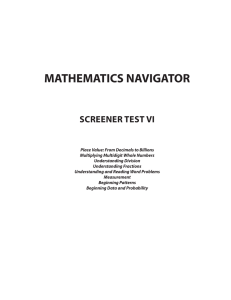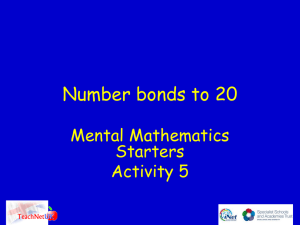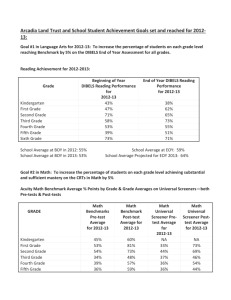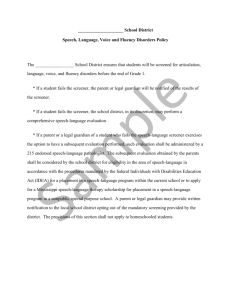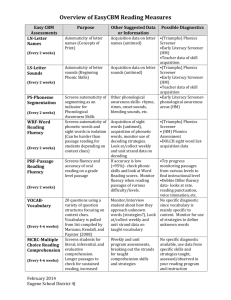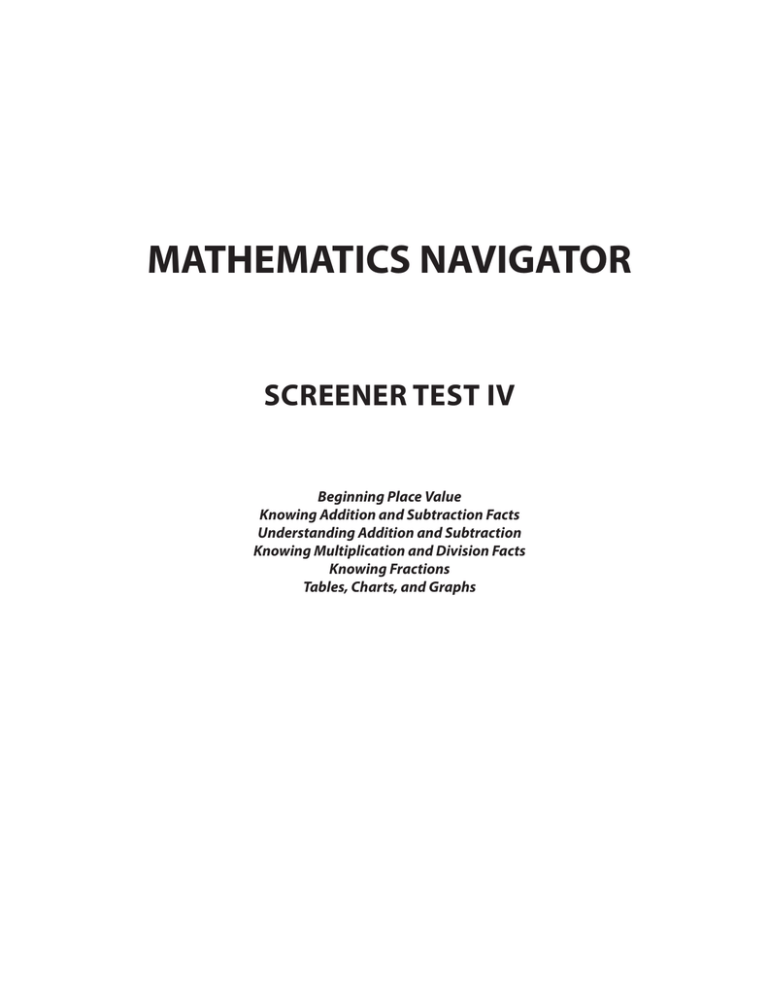
MATHEMATICS NAVIGATOR
Screener Test IV
Beginning Place Value
Knowing Addition and Subtraction Facts
Understanding Addition and Subtraction
Knowing Multiplication and Division Facts
Knowing Fractions
Tables, Charts, and Graphs
This Screener Test has been designed to correlate with the NCTM Curriculum Focal Points.
Each Screener Test focuses on three to eight Mathematics Navigator modules, which in turn
focus on addressing misconceptions students may have about mathematics concepts.
Screener Test IV is designed to be given at the beginning of the school year. It covers the
standards that students need in order to be successful at their grade level.
The results of this Screener Test will help instructors identify gaps in students’ knowledge and
determine which Mathematics Navigator modules will help fill those gaps. Participation in
these modules will help students succeed in mathematics and on their state assessments tests.
America’s Choice® is a subsidiary of the National Center on Education and the Economy® (NCEE), a Washington, DC-based
non-profit organization and a leader in standards-based reform. In the late 1990s, NCEE launched the America’s Choice School
Design, a comprehensive, standards-based, school-improvement program that serves students through partnerships with states,
school districts, and schools nationwide. In addition to the school design, America’s Choice provides instructional systems in
literacy, mathematics, and school leadership. Consulting services are available to help school leaders build strategies for raising
student performance on a large scale.
© 2009 by America’s Choice
All rights reserved. No part of this publication may be reproduced or transmitted in any form or by any means, electronic or
mechanical, including photocopy, recording, or any information storage and retrieval system without permission from the
America’s Choice permissions department.
America’s Choice and the America’s Choice logo are registered trademarks of America’s Choice. The National Center on
Education and the Economy is a registered trademark of The National Center on Education and the Economy.
First Printing 2009
1 2 3 4 5 6 7 8 9 10 12 11 10 09 08
ISBN 978-1-60637-601-0
http://www.americaschoice.org
e-mail: products@americaschoice.org
Screener Test IV
1. Select the appropriate symbol to fill in the blank.
152 ___ 125
A.
>
B.
<
C.
=
D.
≥
–––––––––––––––––––––––––––––––––––––––––––––––––––––––––––––––––––––––––––––––––––––
2. Which set of base-10 blocks shows the number 124?
A.
B.
C.
D.
➥
GO ON
©America’s Choice
Mathematics Navigator
|
Screener Test IV
3. Miguel used this number line to count by a number.
0 1 2 3 4 5 6 7 8 9 10 11 12 13
Which number did Miguel count by?
A.
3
B.
4
C.
5
D.
12
–––––––––––––––––––––––––––––––––––––––––––––––––––––––––––––––––––––––––––––––––––––
4. Gabby is counting by tens.
Which number line shows this?
A.
5 10 15 20 25 30 35 40 45 50 55 60 65 70
B.
5 10 15 20 25 30 35 40 45 50 55 60 65 70
C.
5 10 15 20 25 30 35 40 45 50 55 60 65 70
D.
5 10 15 20 25 30 35 40 45 50 55 60 65 70
–––––––––––––––––––––––––––––––––––––––––––––––––––––––––––––––––––––––––––––––––––––
5. Which answer choice shows two correct names for 70?
A.
seven tenths
seven tens
B.
seventy
seven ones
C.
D.
|
seven tenths seven ones
seventy
Screener Test IV
seven tens
➥
GO ON
©America’s Choice
Screener Test IV
6. Maria has packs of paper. 4 of her
packs each have 100 sheets. 5 of her
packs each have 10 sheets.
How many sheets of paper does she
have in all?
9. Maria scored 25 points in her first
game of basketball and 14 points in
her second game.
How many points did she
score altogether?
A.
45
A.
11
B.
105
B.
38
C.
450
C.
29
D.
540
D.
39
–––––––––––––––––––––––––––––––––––––––––
7. What is the missing number in this
counting pattern?
?
102,
–––––––––––––––––––––––––––––––––––––––––
10. 2 + 8 = W + 2
, 122, 132, 142,…
A.
2
A.
103
B.
6
B.
111
C.
8
C.
112
D.
10
D.
121
–––––––––––––––––––––––––––––––––––––––––
8. Which equation can be used to find
the missing number?
–––––––––––––––––––––––––––––––––––––––––
11. Which equation can be used to find
the missing number?
W+3=7
13
– ?
4
A.
7−3=W
B.
W−3=7
3−7=W
7+3=W
C.
D.
A.
13 + 4 = ???
B.
4 − 13 = ???
C.
??? = 13 − 4
D.
Either A or C
➥
GO ON
©America’s Choice
Mathematics Navigator
|
Screener Test IV
12. Malaya had $26 to spend. She bought
a CD for $14.
14. Miguel bought a jacket for $8 less than
the price shown.
How much money did she have left?
A.
$2
B.
$12
C.
$13
D.
$40
–––––––––––––––––––––––––––––––––––––––––
13. Maria was playing a computer game.
She scored 43 points in Round 1 and
26 points in Round 2.
Amir bought the same jacket for $83.
How much more did Amir pay?
A.
$3
B.
$5
C.
$8
D.
$9
Which expression could she use to add
the points together?
A.
40 + 20 + 3 + 6
B.
4+3+2+6
C.
40 + 30 + 20 + 60
D.
30 + 4 + 60 + 2
➥
GO ON
|
Screener Test IV
©America’s Choice
Screener Test IV
15. Tamika, Maria, and Anthony each have some strawberries.
Tamika’s
strawberries
Maria’s
strawberries
Anthony’s
strawberries
Which number line shows how to find the total number of strawberries?
A.
0 1 2 3 4 5 6 7 8 9 10 11 12 13 14 15 16
B.
0 1 2 3 4 5 6 7 8 9 10 11 12 13 14 15 16
C.
0 1 2 3 4 5 6 7 8 9 10 11 12 13 14 15 16
D.
0 1 2 3 4 5 6 7 8 9 10 11 12 13 14 15 16
–––––––––––––––––––––––––––––––––––––––––––––––––––––––––––––––––––––––––––––––––––––
16. Three students were eating grapes. Amir ate 24, Josh ate 33, and Gabby ate 21.
How many grapes did they eat altogether?
A.
77 grapes
B.
78 grapes
C.
87 grapes
D.
88 grapes
➥
GO ON
©America’s Choice
Mathematics Navigator
|
Screener Test IV
17. Mr. Hakim has 2 boxes of pencils.
Each box has 6 pencils. He gives away
4 pencils from each box.
20. Which equation describes
these shapes?
Which expression can be used to find
the total number of pencils he has left?
A.
6+6−4
B.
2+6+4
C.
2+6−4−2
D.
6+6−4−4
–––––––––––––––––––––––––––––––––––––––––
18. Which equation does the number
line show?
−20
80
100
A.
80 − 20 = 100
B.
80 + 20 = 100
C.
100 − 80 = 20
D.
100 − 20 = 80
–––––––––––––––––––––––––––––––––––––––––
19. 8 • 21 =
• 42
A.
3•9=9•3
B.
9•9=9•9
C.
3+3+3=3+3+3
D.
9+9=9+9
–––––––––––––––––––––––––––––––––––––––––
21. Tamika put 40 biscuits on a tray. She
put 8 biscuits in each row. How many
rows of biscuits were on the tray?
A.
320
B.
5
C.
8
D.
48
–––––––––––––––––––––––––––––––––––––––––
22. 18 children said they wanted to play
games. The teacher said they must
play in equal-sized groups with no
one left out.
What size group would work?
A.
1
A.
3 groups of 4
B.
4
B.
2 groups of 10
C.
8
C.
2 groups of 8
D.
16
D.
3 groups of 6
➥
GO ON
|
Screener Test IV
©America’s Choice
Screener Test IV
23. Which equation does this number
line represent?
0
49
A.
8×7
B.
7×7
C.
6×8
D.
6×7
25. Which example shows
1
?
2
L
M
•
M
0
inches
1
2
N
P
–––––––––––––––––––––––––––––––––––––––––
24. Which division equation is equal to
this multiplication equation?
A.
Example L
3 • 7 = 21
B.
Example M
C.
Example N
D.
Example P
A.
7 ÷ 3 = 21
B.
21= 3 ÷ 7
C.
7 = 21 • 3
D.
21 ÷ 7 = 3
➥
GO ON
©America’s Choice
Mathematics Navigator
|
Screener Test IV
26. Josh cut a cake and ate
1
of it. Which description matches this situation?
8
A.
Josh cut the cake in 16 equal pieces and ate 3 of them.
B.
Josh cut the cake in 8 equal pieces and ate 2 of them.
C.
Josh cut the cake in 8 equal pieces and ate 1 of them.
D.
Josh cut the cake in 18 equal pieces and ate 1 of them.
–––––––––––––––––––––––––––––––––––––––––––––––––––––––––––––––––––––––––––––––––––––
27. Which point on the number line shows
AB
C
••
0
A.
Point A
B.
Point B
C.
Point C
D.
Point D
5
?
4
D
•
1
•
2
3
➥
GO ON
|
Screener Test IV
©America’s Choice
Screener Test IV
28. Which ruler shows
3
inch?
4
•
A.
0
1
2
3
4
5
6
0
1
2
3
4
5
6
0
1
2
3
4
5
6
0
1
2
3
4
5
6
B.
C.
D.
–––––––––––––––––––––––––––––––––––––––––––––––––––––––––––––––––––––––––––––––––––––
29. What fraction of the area of this rectangle is shaded?
A.
4
6
B.
4
2
C.
2
4
D.
2
6
➥
GO ON
©America’s Choice
Mathematics Navigator
|
Screener Test IV
30. Amir receives $10 each week for spending money. He saves
1
of his money each week.
5
How many dollars does Amir save each week?
A.
$1.00
B.
$2.00
C.
$5.00
D.
$10.00
–––––––––––––––––––––––––––––––––––––––––––––––––––––––––––––––––––––––––––––––––––––
31. This list shows the number of pieces of gum chewed by students in Mrs. Chi’s class in
one week. Which line plot shows this information correctly?
Number of Pieces of Gum Chewed
in One Week
Data: 0, 0, 0, 1, 1, 1, 1, 1, 1, 2, 2,
2, 2, 3, 3, 3, 4, 4, 5, 5, 7, 9
A.
Number of Pieces of Gum
Chewed in One Week
X
X
X
X X
X X
X X
X
X
X
X
B.
Number of Pieces of Gum
Chewed in One Week
X X X
X X X X X
X
X
X
XX
XX
X
1 2 3 4 6
Number of Students
X
0 1 2 3 4 5 6 7 8 9
Pieces of Gum
C.
Number of Pieces of Gum
Chewed in One Week
X
X
X
X X
X X
X X
X
X X
X X X X
X X X X
X
X
0 1 2 3 4 5 6 7 8 9
Pieces of Gum
D.
Number of Pieces of Gum
Chewed in One Week
X
X
X X
X X X X
X X X X X X
X X X X X X X X
0 1 2 3 4 5 7 9
Pieces of Gum
➥
GO ON
10
|
Screener Test IV
©America’s Choice
Screener Test IV
32. Tran Li asked the members of a family how many miles they typically walk in a week.
He learned that 8 family members walk 1 mile, 5 family members walk 2 miles,
10 family members walk 3 miles, and 7 family members walk 4 miles.
Which graph correctly represents his data?
Number of Family Members
and How Far They Walk in One Week
B.
Number of Family Members
Number of Family Members
A.
5
4
3
2
1
0
1
2
3
4
Number of Family Members
and How Far They Walk in One Week
10
8
6
4
2
0
1
Number of Miles
Number of Family Members
and How Far They Walk in One Week
10
8
7
5
0
1
2
3
Number of Miles
3
4
Number of Miles
4
D.
Number of Family Members
Number of Family Members
C.
2
Number of Family Members
and How Far They Walk in One Week
12
10
8
6
4
2
0
1
2
3
4
Number of Miles
➥
GO ON
©America’s Choice
Mathematics Navigator
|
11
Screener Test IV
33. What number pair shows the location
of
on this graph?
y
16
34. The table below shows how many
free throws Miguel, Anthony, Maria,
and Anna made. How many more
free throws did Anthony make
than Maria?
Successful Free Throws
15
14
13
12
11
10
10 11 12 13 14 15 16
A.
(2, 5)
B.
(5, 2)
C.
(12, 15)
D.
(15, 12)
x
Number of Free Throws
7
6
5
4
3
2
1
0
Miguel Anthony Maria
Anna
Student
A.
7
B.
2
C.
5
D.
3
➥
GO ON
12
|
Screener Test IV
©America’s Choice
Screener Test IV
35. This pictograph shows data about how many minutes students take to clean
their rooms.
Which of the bar graphs shows the same data?
Time to Clean Rooms
Legend:
= 2 students
25
30
35
40
45
50
Number of Minutes
A.
B.
12
10
9
8
6
3
0
Time to Clean Rooms
Number of Students
Number of Students
Time to Clean Rooms
6
5
4
3
2
1
0
25 30 35 40 45 50
Number of Minutes
C.
12
10
8
6
4
2
0
Number of Minutes
D.
Time to Clean Rooms
Number of Students
Number of Students
Time to Clean Rooms
25 30 35 40 45 50
Number of Minutes
25 30 35 40 45 50
12
10
8
6
4
2
0
25 30 35 40 45 50
Number of Minutes
➥
GO ON
©America’s Choice
Mathematics Navigator
|
13
Screener Test IV
36. Which line plot correctly displays the data from this frequency table?
Average Number of Minutes Students Take to Eat Breakfast
Number of Minutes
5
10
15
20
25
Average Number of Minutes
Students Take to Eat Breakfast
A.
X
X
X
X
X
X
X
5
C.
X
X
X
X
X
X
X
X
X
X
X
X
X
X
X
X
X
X
X
X
X
Number of Students
7
11
5
5
1
B.
Average Number of Minutes
Students Take to Eat Breakfast
X
X
X
X
X
1
5
7
11
Number of Students
X
10
15
20
25
Number of Minutes
Average Number of Minutes
Students Take to Eat Breakfast
X
X
X
X
X
X
X
X
X
X
X
X
X
X
X
X
X
X
X
X
X
X
X
X
X
X
5
10
15
20
25
Number of Minutes
D.
Average Number of Minutes
Students Take to Eat Breakfast
X
X
X
X
X
X
X
5
X
X
X
X
X
X
X
X
X
X
X
X
X
X
X
X
X
X
X
X
X
X
10
15
20
25
Number of Minutes
STOP!
14
|
Screener Test IV
©America’s Choice
Screener Test IV Answer Key
Question Answer
Number
Key
Content Description
Unit
1
A
Uses knowledge of place value to order
multidigit numbers using equality symbols
2
A
Develops an understanding of the base-ten system
and place-value concepts by representing three-digit
numbers accurately with a model
3
B
Develops an understanding of the base-ten system
and place-value concepts by skip counting in
multiples of 4s and using a model
4
D
Develops an understanding of the base-ten system
and place-value concepts by skip counting in
multiples of 10 and using a model
5
D
Uses place value and properties of operations
to recognize equivalent representations of a given
two-digit number (such as “ten” and “ten ones”)
C
Develops an understanding of the base-ten system
and place value by solving a simple addition problem
that involves identifying a three-digit number given
the number of hundreds and tens
7
C
Develops an understanding of the base-ten system
and place-value concepts, including counting in
multiples of hundreds, tens, and ones, by filling in the
missing number in a numerical pattern
8
A
Uses known addition facts and an understanding
of the inverse relationship between addition and
subtraction to solve a problem
9
D
Solves addition problems in the context of a word
problem by using efficient procedures for adding
and subtracting, including applying place value
knowledge, counting by tens and ones, and using
known addition facts
10
C
Solves addition problems using the commutative
property of addition
C
Uses known addition facts and an understanding
of the inverse relationship between addition and
subtraction to solve a problem
B
Solves subtraction problems in the context of a word
problem by using efficient procedures, including
applying place value knowledge, counting by tens
and ones, and using known subtraction facts
6
11
12
©America’s Choice
Beginning
Place Value
Knowing
Addition and
Subtraction
Facts
Mathematics Navigator
|
15
Screener Test IV Answer Key
Question Answer
Number
Key
Content Description
13
A
Applies an understanding of models of addition
and subtraction and relationships and properties
of numbers (such as place value) to recognize the
expanded form of an addition expression that
matches a word problem
14
B
Uses known addition facts and related subtraction
facts to solve a two-step word problem
C
Develops an understanding of models of addition and
subtraction by identifying the addition process in a
word problem and matching it with a number line
16
B
Solves addition problems involving two digits in
the context of a word problem by using efficient
procedures for adding and subtracting, including
applying place value knowledge
17
D
Selects and applies appropriate methods to solve a
word problem that involves adding and subtracting
18
D
Develops an understanding of models of addition
and subtraction by matching an expression to a
number line
19
B
Uses multiplication strategies of halving and doubling
to find an equivalent expression
A
Develops an understanding of the meanings of
multiplication of whole numbers using arrays,
number patterns, and the commutative property
B
Identifies the appropriate calculation needed to
solve a word problem and uses division strategies
such as grouping and repeated subtraction to solve
the problem
22
D
Solves division problems using known multiplication
and related division facts and by using strategies such
as grouping, doubling, and halving
23
B
Solves multiplication problems using number lines
and strategies such as repeated addition
24
D
Compares a variety of solution strategies in
order to relate multiplication and division as
inverse operations
15
20
21
16
|
Screener Test IV
Unit
Understanding
Addition and
Subtraction
Knowing
Multiplication
and Division
Facts
©America’s Choice
Screener Test IV Answer Key
Question Answer
Number
Key
Content Description
Unit
25
A
Uses an understanding of equal parts and the
meanings of fractions to represent parts of a whole,
parts of a set, or points or distances on a number line
26
C
Solves word problems by recognizing that the size of
a fractional part is relative to the size of the whole
27
C
Develops an understanding of the meanings of
fractions by identifying a fraction on a number line
28
D
Develops an understanding of the meanings of
fractions by identifying a fraction on a ruler
29
A
Develops an understanding of the uses of fractions by
representing parts of a whole
30
B
Develops an understanding of the idea that the size of
a fractional part is relative to the size of the whole by
solving word problems involving fractions
31
C
Finds relationships between different representations
of the same data by analyzing a line plot to determine
which one matches a given set of data
32
B
Develops an understanding of how to represent data
by identifying the bar graph that accurately displays
data presented in a word problem
33
D
Plots points in the first quadrant of a coordinate grid
34
C
Analyzes and extracts information from a bar graph
in order to solve a problem
35
D
Analyzes different representations of data, including
graphs in which the scale is not one-to one, in order
to determine which representations display the
same data
36
D
Represents data from tables in line plots
©America’s Choice
Knowing
Fractions
Tables, Charts,
and Graphs
Mathematics Navigator
|
17

